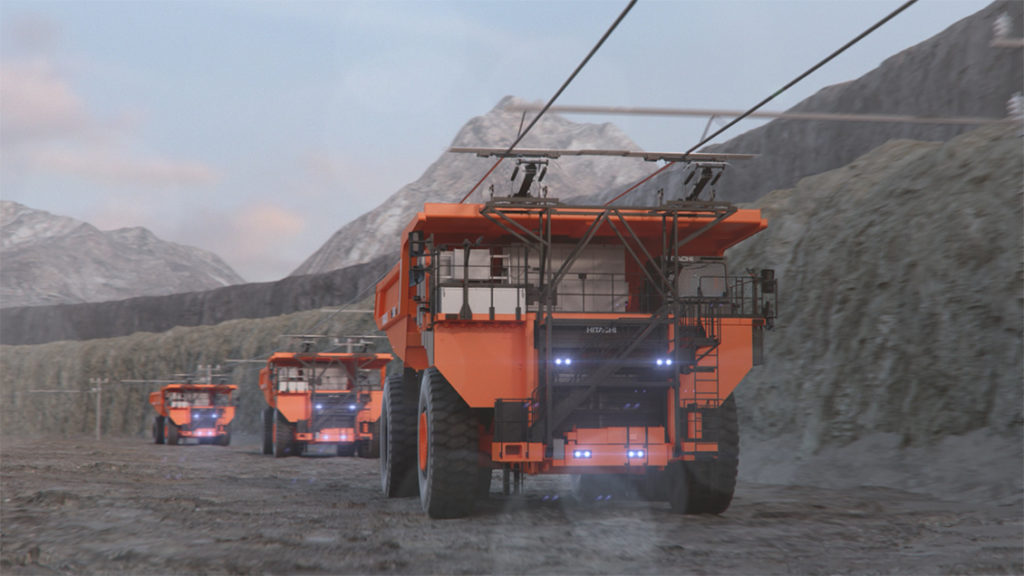Hitachi Construction Machinery Shares Advantages of Battery Electric Mining Truck
Mine site electrification important step in drive toward net-zero carbon emissions.
Today’s mine sites are looking for sustainable solutions as they strive to cut their carbon footprint to achieve environmental, social and governance (ESG) goals without sacrificing performance. This is critical as demand for minerals continues to increase as the pandemic subsides and the drive toward low-emission transportation solutions gains momentum.
Mine sites are getting serious about decarbonization, and more are exploring electrification as a possible solution to reduce greenhouse gas emissions. The business case for making the transition is further bolstered by fuel-price spikes, which significantly impact mine sites’ operating costs. To address this growing demand for electrification, companies are forming partnerships that will help speed the transformation.
Hitachi Construction Machinery (HCM) has been at the forefront of the march toward mine site electrification with established trolley truck technology and electric mining excavators and shovels. On March 22, 2021, HCM signed a memorandum of understanding with ABB to help accelerate the transition to all-electric mines. This was followed by a collaboration agreement signed on June 23, 2021, to develop an engineless, full-battery rigid-frame haul truck. Using ABB’s innovative battery technology, Hitachi haul trucks can be transformed from diesel to full-electric battery operation.

The two companies will apply their complementary skills to reduce emissions. ABB is a leading global technology company that specializes in electrification, robotics and automation. It will develop onboard energy storage systems by customizing an existing product. HCM will lead the overall design and development of the dynamic-charging battery haul truck using its existing haul-truck trolley technology as its base.
The haul trucks will use a new onboard electrification system. It will draw energy from a dynamic charging system, which will allow simultaneous charging of the onboard energy storage system while providing energy to power the truck. This dynamic charging system takes the form of a trolley system and allows electrical energy to be quickly transferred from the grid to the haul truck.
Trolley systems cut fuel use
Trolley assist technologies are not new, they have actually existed for decades. The technology has not yet been widely adopted despite several inherent advantages. With fuel prices continuing to climb, trolley assist technology is well positioned for the future. The increasing popularity of diesel-electric trucks simplifies the implementation of a trolley assist system. These trucks already have an electrical system on board to tap into, which makes it easier to put them on a trolley line.
A trolley-assist system is a proven, effective way to slash fuel consumption in a diesel electric truck. It enables a secondary means of powering the wheel motors in high-demand segments of the haulage route. Operators can easily change from trolley to diesel with the flick of a switch. When this is activated, diesel-generated power is cancelled, and overhead catenary power is connected and diverted to the wheel motors through inverters and a trolley switch box.
HCM manufactures and supports the trolley-system components on its haul trucks. The system uses low-cost electric power for better economy and reduced running costs. Because the engine speed on the Hitachi truck in trolley mode is lower than any other diesel-electric machines or conventional diesel trucks, it burns less diesel fuel. Productivity is also a factor. In many cases, when the trucks are under the trolley, they can climb up the ramp at greater speed.
Eliminating the diesel engine
By combining the trolley system with battery technology, the diesel engine can be completely removed from the haul truck. Owners get the advantages of the trolley-assist system while burning no diesel in the truck, which is an important step in the drive to zero emissions.
In order to successfully implement battery technology and overcome significant energy storage constraints compared to diesel, the designers must focus on energy efficiency. For instance, energy can be captured and reused during braking, and energy use can be limited when the vehicle is not traveling.
By drawing power from the overhead system while connected and simultaneously charging the battery, the load and depth of discharge is reduced, maximizing battery life. This also allows operators to limit the size of the battery, maximizing the haul truck’s payload. Since the vehicle does not have to stop for recharging, operators can maintain a higher rate of continuous operation.
The prototype battery electric mine haul truck is currently in development. It promises another step forward toward a sustainable future. HCM and ABB’s joint solution promises to contribute to net-zero emissions of greenhouse gases from mining machinery.
To experience the Hitachi mining solutions portfolio – including intuitive, heavy-duty mining excavators and the most technologically advanced mining trucks on the market visit hitachicm.us/mining.

2 Comments
Raed Limoun
Kind need to know price of dump trucks and availability time .
Chris McSweeney
The article does not mention the possibility of feeding power into the catenary when the trucks are going downhill? That was a suggested open pit “trolley-assist” system about three decades ago. Seems that idea has now been outmoded by on-board batteries. If so, that shift in thinking might have been mentioned.